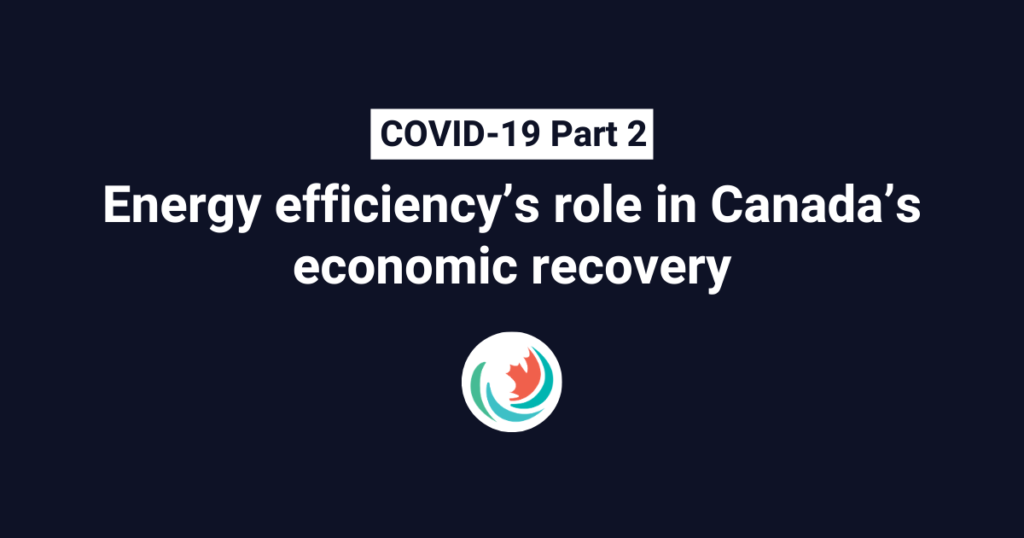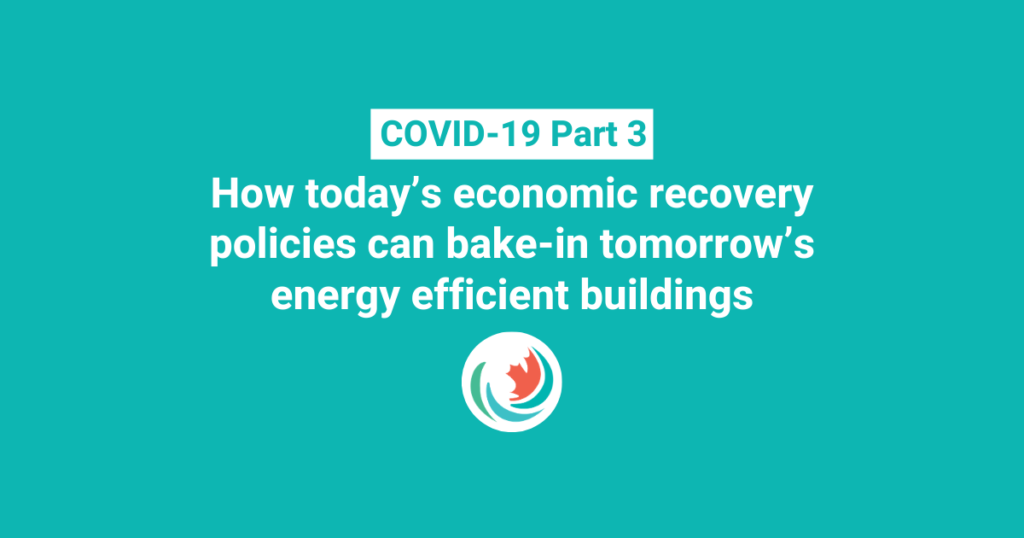Energy efficiency programs are “shovel-ready”
New benchmarking data shows Canadian jurisdictions could catch up to leading American states
Brendan Haley
May 11, 2020
Blogs | EE Recovery | News
- A first North American benchmarking of energy savings shows Canadian provinces have room to catch up to leading American states
- Ramping up savings and budgets to the levels reached in leading jurisdictions is an achievable goal for post COVID-19 economic recovery, with potential to create 175,000 annual jobs
- Expanding the scale and scope of existing efficiency program portfolios present a “shovel-ready” stimulus initiative, with measurement and accountability systems already in place.
Last year Efficiency Canada released its first Canadian provincial policy scorecard. In preparation for a conference, we worked with the American Council for an Energy Efficient Economy (ACEEE) to compare energy savings and targets across the provinces and states. Our benchmarking shows the Canadian provinces have room to catch up to the leading American states.
This blog shows some of the preliminary results, because they are particularly relevant to the discussion on a clean and resilient economic recovery from COVID-19. Increasing the scale and scope of existing efficiency program portfolios to the leading North American jurisdictions presents a “shovel-ready” and “shovel-worthy” economic stimulus initiative, with the ability to create 175,000 annual jobs and increase annual GDP by $42.5 billion.
In the scorecard we tracked annual incremental savings and targets as a percentage of sales, by fuel type, to enable comparison with the ACEEE state scorecard
See below for results for electricity savings and targets, and natural gas savings
Electricity savings
| State/Province | 2018 savings as % of retail sales | North American rank |
|---|---|---|
| Massachusetts | 2.82% | 1 |
| Rhode Island | 2.79% | 2 |
| Vermont | 2.30% | 3 |
| Maryland | 1.87% | 4 |
| Illinois | 1.66% | 5 |
| California | 1.62% | 6 |
| Hawaii* | 1.47% | 7 |
| Michigan | 1.46% | 8 |
| Ontario* | 1.41% | 9 |
| Connecticut | 1.37% | 10 |
| Minnesota | 1.33% | 11 |
| Nova Scotia | 1.32% | 12 |
| Arizona | 1.27% | 13 |
| District of Columbia | 1.23% | 14 |
| Washington | 1.18% | 15 |
| New York | 1.16% | 16 |
| Ohio | 1.14% | 17 |
| Iowa | 1.08% | 18 |
| Colorado | 1.07% | 19 |
| Maine | 1.05% | 20 |
| Oregon | 0.95% | 21 |
| Idaho | 0.87% | 22 |
| New Hampshire | 0.75% | 23 |
| Pennsylvania | 0.74% | 24 |
| Wisconsin | 0.72% | 25 |
| Utah | 0.70% | 26 |
| Arkansas | 0.68% | 27 |
| Manitoba | 0.68% | 28 |
| North Carolina | 0.67% | 29 |
| British Columbia | 0.64% | 30 |
| Missouri | 0.61% | 31 |
| Nevada | 0.59% | 32 |
| New Brunswick | 0.57% | 33 |
| New Mexico | 0.56% | 34 |
| Indiana | 0.55% | 35 |
| Montana | 0.51% | 36 |
| Oklahoma | 0.50% | 37 |
| South Carolina* | 0.49% | 38 |
| Newfoundland and Labrador | 0.47% | 39 |
| New Jersey | 0.35% | 40 |
| Québec | 0.29% | 41 |
| Mississippi | 0.28% | 42 |
| Nebraska | 0.26% | 43 |
| Alberta | 0.26% | 44 |
| Georgia | 0.25% | 45 |
| Wyoming | 0.24% | 46 |
| Saskatchewan | 0.21% | 47 |
| South Dakota | 0.20% | 48 |
| Prince Edward Island | 0.20% | 49 |
| West Virginia | 0.19% | 50 |
| Texas | 0.18% | 51 |
| Delaware | 0.15% | 52 |
| Tennessee | 0.13% | 53 |
| Kentucky | 0.12% | 54 |
| Florida | 0.09% | 55 |
| Louisiana | 0.05% | 56 |
| Virginia | 0.05% | 57 |
| Alabama | 0.03% | 58 |
| North Dakota* | 0.01% | 59 |
| Alaska* | 0.00% | 60 |
| Kansas* | 0.00% | 61 |
| North American Median | 0.61% |
* States/provinces which did not have 2018 savings data were scored on 2017 savings.
All Canadian provinces reported net savings. Some states reported at least some of their savings as gross. In which case ACEEE applied a 0.8413 net-to-gross factor to gross savings. For further information see table 7 in the 2019 ACEEE State Scorecard.
The leading American states (Massachusetts, Rhode Island, Vermont) have consistently achieved annual electricity savings in the range of 2-3% of their retail sales. From a North American perspective, Ontario ranks 9th, and Nova Scotia 12th. Note, however, that Ontario announced major budget cuts to electricity programs that will reduce program savings in the future.
Electricity savings targets
| State/Province | Approx. annual electric savings target as % of retail sales (2020-2025) |
|---|---|
| Massachusetts | 2.7% |
| Rhode Island | 2.5% |
| Maine | 2.4% |
| Vermont | 2.4% |
| Arizona | 2.1% |
| New York | 2.0% |
| Maryland | 2.0% |
| Illinois | 1.7% |
| Colorado | 1.7% |
| New Jersey | 1.5% |
| Minnesota | 1.5% |
| Hawaii | 1.4% |
| New Hampshire | 1.3% |
| California | 1.3% |
| Oregon | 1.3% |
| Arkansas | 1.2% |
| Virginia | 1.2% |
| Connecticut | 1.1% |
| Nevada | 1.1% |
| Nova Scotia | 1.1% |
| Michigan | 1.0% |
| New Mexico | 1.0% |
| Washington | 0.9% |
| Iowa | 0.9% |
| Pennsylvania | 0.8% |
| New Brunswick | 0.8% |
| Wisconsin | 0.7% |
| Prince Edward Island | 0.7% |
| Ontario t | 0.7% |
| British Columbia | 0.5% |
| Manitoba * | 0.5% |
| North Carolina | 0.4% |
| Québec | 0.3% |
| Newfoundland and Labrador | 0.3% |
| Saskatchewan | 0.3% |
| Texas | 0.2% |
| Ohio | 0.0% |
| Alberta | No target |
* Manitoba has legislated annual and multi-annual targets for electricity and natural gas under the Efficiency Manitoba Act. These targets include savings from both programs and economy-wide codes and standards. Since the demand side management plan for the new Efficiency Manitoba crown corporation was not yet approved during data collection, the program-specific targets here are based on planning documents, and significantly lower than what was proposed by Efficiency Manitoba.
t Ontario targets updated, assuming implementation of efficiency savings projected in IESO Planning Outlook.
When we look at electricity targets, Canadian provinces are further behind, and we see that many American jurisdictions are raising their ambition. The top 10 states are targeting savings higher than 1.5%, while the top Canadian electricity savings target is 1.1% in Nova Scotia.
Natural gas savings
| State / Province | 2018 savings as % of retail sales | North American rank |
|---|---|---|
| Québec | 1.32% | 1 |
| Rhode Island | 1.14% | 2 |
| Massachusetts | 1.05% | 3 |
| Maine | 0.85% | 4 |
| Minnesota | 0.83% | 5 |
| District of Columbia | 0.76% | 6 |
| New Hampshire | 0.72% | 7 |
| Michigan | 0.71% | 8 |
| Quebec (utility only) | 0.65% | 9 |
| Utah | 0.56% | 10 |
| Oregon | 0.56% | 11 |
| California | 0.53% | 12 |
| Connecticut | 0.50% | 13 |
| New York | 0.49% | 14 |
| Ontario* | 0.44% | 15 |
| Wisconsin | 0.42% | 16 |
| Vermont | 0.42% | 17 |
| Arizona | 0.39% | 18 |
| Maryland | 0.31% | 19 |
| Arkansas | 0.27% | 20 |
| Illinois | 0.27% | 21 |
| Iowa | 0.26% | 22 |
| New Jersey | 0.25% | 23 |
| British Columbia | 0.23% | 24 |
| Washington | 0.22% | 25 |
| Alberta | 0.22% | 26 |
| Delaware | 0.19% | 27 |
| Colorado | 0.19% | 28 |
| Oklahoma | 0.16% | 29 |
| New Mexico | 0.14% | 30 |
| Manitoba | 0.13% | 31 |
| Montana | 0.12% | 32 |
| Indiana | 0.11% | 33 |
| Idaho | 0.06% | 34 |
| Mississippi | 0.06% | 35 |
| North Carolina | 0.05% | 36 |
| Saskatchewan | 0.04% | 37 |
| South Dakota | 0.04% | 38 |
| Florida | 0.03% | 39 |
| Pennsylvania | 0.03% | 40 |
| North American Median | 0.27% |
* 2016 data was latest year available in Ontario.
All Canadian provinces reported net savings, except for TEQ programs in Québec which are reported as gross. The Canadian scorecard attached a 0.8 net-to-gross ratio to estimate net savings. To compare with the American scorecard, this table uses the 0.8413 net-to-gross ratio applied in the American 2019 scorecard. It should also be noted that Ontario has a very low 0.382 net-to-gross ratio. Ontario gross savings are equal to 1.1% of sales. The North American median only counts Québec with TEQ savings.
Our annual natural gas savings figures show that Québec is the top saver in North America, based on this savings as percentage of sales metric. The 1.32% of sales figure includes savings from both the principal natural gas utility (Énergir) and a government agency (Transition énergétique Québec) that also operates natural gas programs. If we only count savings from the principal utility, Québec would still be in the top ten North American jurisdictions.
The Québec results are explained by both policy and market context. The policy explanation recognizes the importance of TEQ programs, which are principally funded by cap-and-trade system revenues as well as a charge on energy distribution companies. These funds are targeted towards GHG emission reductions, which are currently focused on natural gas and transportation savings. This leading North American result shows what can be accomplished by combining utility and government funding.
The Québec results are also explained by a market almost entirely dominated by industrial and commercial natural gas customers, as most residential buildings use electrical heat in Québec’s hydroelectric dominated grid. Québec natural gas programs can achieve big energy savings per dollar spent in these markets.
Unfortunately, we do not have data to compare savings in fuel oil which dominates the Atlantic Canadian heating markets (hence their exclusion from the table above). Next year’s Canadian scorecard aims to collect data on both natural gas and heating fuel savings.
Explaining the Canadian results
The driving factor that explains the results in the leading states is policy. Massachusetts, Rhode Island, and Vermont have mandates that require investing in all energy efficiency solutions that are lower cost than supply. No Canadian province has instituted a clear “all cost-effective” efficiency resource standard, and several provinces have arbitrary budget restrictions even though studies indicate greater energy savings potential.
Many Canadian jurisdictions dominated by hydroelectricity are facing electricity surpluses, which means the shorter-term costs that electricity savings can avoid are lower. However, energy savings are still cost-effective when considering longer-term system costs and policy goals, while fully accounting for all energy efficiency benefits. Canadian electricity savings will need to increase if province’s are going to meet their ambition to massively electrify transportation and heating systems. An analysis in Québec found that energy efficiency is key to cost-effectively freeing up hydroelectricity to power vehicles, and a Newfoundland and Labrador study showed continued electricity energy efficiency could manage the peak demands from a large-scale program to replace heating oil with heat pumps.
Leading states are also ahead of most Canadian jurisdictions by accounting for the multiple benefits of energy efficiency. For instance, Massachusetts program screening policies consider participant health benefits, productivity improvements, comfort, and additional savings in water and other fuels.
In the context of economic recovery, the benefits outside of those typically considered in utility systems will be particularly important – benefits such as job creation, support for the most vulnerable, increasing spending in local economies, health, resilient infrastructure, and greenhouse gas reductions.
Scaling-up programs as a stimulus strategy
News reports say the federal government is searching for “shovel-ready” initiatives to support economic recovery from COVID-19. The federal government can leverage an already existing program delivery infrastructure to provide rapid, accountable, and effective support to Canadians.
Previous experience suggests governments should avoid lengthy internal approval processes, fund whole programs to avoid cherry-picking projects, use third-party validation, and have systems to closely track progress. Existing energy efficiency program portfolios meet all of these criteria. Supporting a portfolio of residential, commercial, and industrial programs means administrators can flexibility adjust strategies that make sure the money is actually spent and jobs are created, while adopting to different COVID-19 re-opening policies. Efficiency programs undergo a thorough review process overseen by utility regulators, involving scrutiny by third-party experts and stakeholders. There are established systems for cost-effectiveness testing; evaluation, measurement and verification; and performance tracking.
Scale-up funding can be provided from existing federal initiatives. In particular, the Low-Carbon Economy Fund, the Climate Action Incentive Fund, and the Energuide program. Scaling up efficiency programs also deliver on stimulus objectives to create jobs and boost GDP. Our Less is More study included a “Pan-Canadian Framework Plus” scenario that increased the annual savings metrics reported above to 2% for electricity, 1.3% for natural gas, and 1.9% for refined petroleum products — in every province — in the first five years. The savings then grew to 2.5%, 1.75%, and 2.5% respectively. These results are achieved by increasing budgets by $2.2 billion in year one, scaling up to $11.9 billion, on average over 14 years. These investments create 35,000 jobs in the first year, increasing to 280,000 annual jobs in year 8, while providing a $43 billion average annual increase in GDP, and 79 Mt of GHG reductions in 2030.
Within a portfolio approach to enable flexibility and adaptation, it is also possible for the federal government to place emphasis on performance criteria that prioritizes economic stimulus and greenhouse gas reductions. These include:
Deeper retrofits
Most residential efficiency programs achieve less than 20% energy savings per house, and we need to get to at least 50% savings to meet climate objectives. Given that 60% of expenditure on home retrofits goes towards labour, focusing on deeper retrofits is a strong job creator.
Energy poverty
Twenty per cent of Canadian households face energy poverty, and will be most affected by a recession. Directing immediate support for low and moderate income households will increase local spending multipliers, and leverage existing programs that are often impeded by restrictive cost-benefit criteria.
Advanced building codes
Promoting activities to advance building code adoption was a key component of American post-2008 stimulus efforts as explained in this blog. Promoting the introduction of Canada’s soon to be released model building codes will create the certainty manufacturers and builders need to re-tool and re-train – providing a boost to business confidence and a direction for private investment.
Heating system market transformation
Deeper retrofits and GHG reductions require switching to more efficient and low-carbon heating systems like heat pumps. Federal support can help break through “fuel silos” that can exist at provincial levels, and promote market transformation objectives.
To conclude, this year’s North American benchmarking shows that every Canadian province has room to catch up to the energy savings levels achieved in leading American states. Catching up to these leaders now presents a readily available way to create jobs and boost GDP as part of a green economic recovery from COVID-19.




